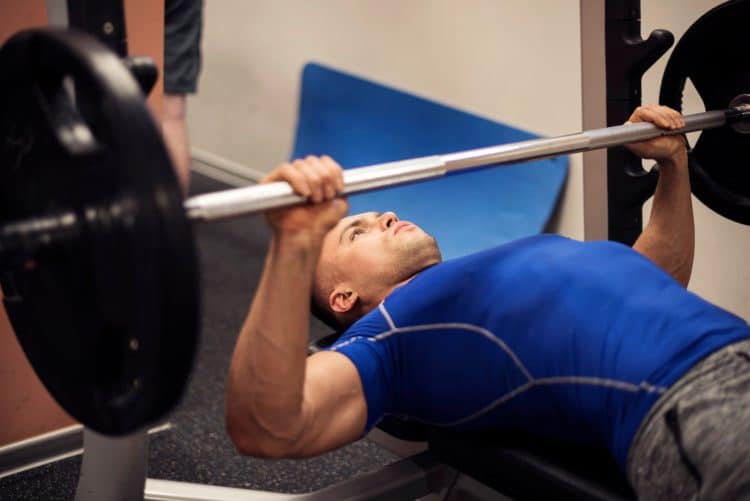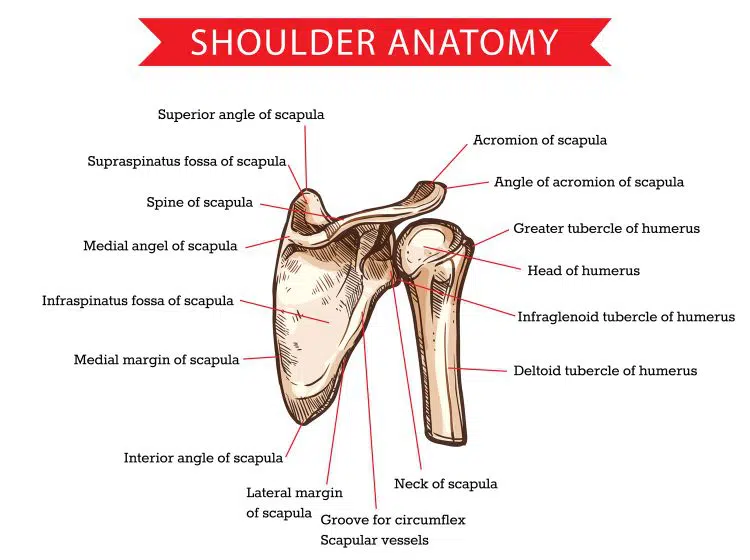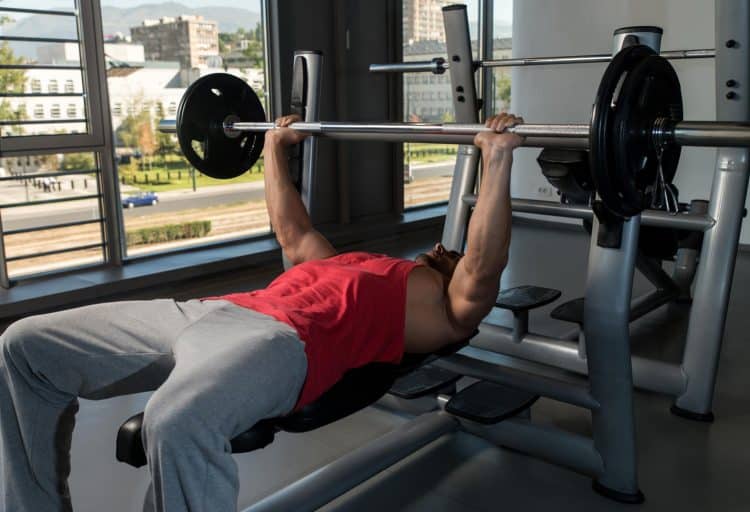It doesn’t matter who you are, where you are from, or what you do, you’ll experience shoulder pain at some point if you lift heavy on the bench press without proper guidance. Since you’re reading this article, we assume you are dealing with shoulder pain while bench pressing.
Although bench press shoulder pain can be acute and annoying, the good news is that it is a temporary blip in most cases. A small, albeit nagging, inconvenience on a long journey.
The bench press is a compound (multi-joint) exercise that helps build a muscular and strong chest. However, it can put significant stress on tissues reinforcing the shoulder joint. Shoulder pain during the bench press is usually caused by excessive stress on the shoulder rotator cuffs.
Besides the rotator cuffs, the glenoid labrum and the pectoralis major muscle are susceptible to injury while performing the bench press. The glenoid labrum has the greatest range of motion of any articulation in the body, making it highly vulnerable to injury.
Although shoulder pain during bench presses can be bothersome, it can be fixed by identifying the underlying issues and addressing them with appropriate steps.
What is Bench Press Shoulder Pain?

Level Up Your Fitness: Join our 💪 strong community in Fitness Volt Newsletter. Get daily inspiration, expert-backed workouts, nutrition tips, the latest in strength sports, and the support you need to reach your goals. Subscribe for free!
Different people might experience shoulder pain at varying positions throughout the bench press range of motion. The problem could stem from a lack of mobility, stiffness, or using an incorrect form. Furthermore, while some lifters might experience shoulder pain during the bench press in their anterior deltoids, others might feel discomfort in their medial delts or shoulder blades.
The pain point and its intensity can signal different shoulder issues and their severity. If untreated for an extended period, a shoulder injury can become more severe and might make you dismiss the bench press from your training routine.
Shoulder Anatomy & Most Common Bench Press Shoulder Injuries
‘Shoulder’ refers to the three deltoid heads, the rotator cuff muscles, the acromioclavicular joint, the shoulder blades, and the labrum that stabilizes the ball and socket joint of the shoulder.
Rotator cuffs are the most common site of shoulder injuries. They comprise four muscles and tendons that surround your shoulder joint. They help the shoulders move and stabilize the joint. However, they are the most prone to injury while performing the bench press. You could inflame (subacromial bursitis) or tear your rotator cuff if you do not properly warm up your shoulders before training.
Subacromial bursitis is a condition when there is pressure on the shoulder bursa, causing it to erode. It increases the friction in your shoulder joint, which can lead to inflammation.
You could also tear your glenoid labral while bench pressing. It is a soft tissue surrounding the shoulder joint.
Shoulder Injury Symptoms
Many people do not even realize when they injure their shoulder while bench pressing as the initial muscle tissue damage can be too small to cause immediate discomfort. Knowing what to look for can help save you from worsening your shoulder issue.
A shoulder injury could result in shoulder or arm pain. You could also experience tenderness, swelling, numbness, or unusual crackling or grinding noises in your shoulder or arm. Furthermore, the symptoms (and pain) might vary depending on the severity of the shoulder injury.
Major bench press injuries like pec tears usually result in discoloration or disformity of the side chest near the shoulder joint. Injuries like the bench press usually require immediate medical attention. On the other hand, shoulder pains or discomfort felt while performing the bench press can be addressed by changing your training routine. (More on it later in this article.)
Shoulder Pain During Bench Press — Main Pain Points
There are two main areas where you might feel pain while performing the bench press — anterior delts and shoulder blades. Here is how to diagnose your bench press shoulder pain and steps to fix it:
1. Anterior Delts
It is the more common shoulder pain type while performing the bench press.
Lay supine on a flat bench or the floor. Grab an imaginary barbell with an overhand grip. Now, analyze your position at this point. Are your shoulders rounded forward as you reach for the barbell? If yes, this is where the problem lies, as it can overexert your shoulder rotator cuffs.
How to fix: Retract your shoulders and pinch your shoulder blades as if holding a pen between your rhomboids. It will ensure you don’t round your shoulders or back while performing the bench press.
2. Shoulder Blades
Some lifters don’t experience pain in the front delts while bench pressing and instead feel a pinch in their shoulder blades. The pain can be dull or sharp, depending on the severity of your condition.
How to fix: Lifting too heavy, using an improper form, and muscular imbalances are the main causes of shoulder blade pain while bench pressing.
Bench Press Shoulder Pain Causes
The bench press is notorious for causing injuries. However, on close inspection, you’ll find that it is usually the beginners or advanced lifters that end up hurting themselves while bench pressing.
The most common reasons for bench press shoulder pain include:
1. Lack of Mobility
Mobility and flexibility are often overlooked while performing the bench press. However, a lack of either can be detrimental to your shoulder health. Include flexibility and mobility drills into your training regimen to lower the risk of injury during your workout.
2. Incorrect Form
Now, incorrect bench press form is a topic in itself. Many lifters hurt their shoulders while bench pressing because they have never been taught (or made the effort to learn) the correct bench pressing technique. Here are a few bench press technical errors you should avoid:
i) Flaring Your Shoulders Too Wide
Most trainers make the mistake of flaring their elbows too wide while performing the bench press. Your upper arms should not be perpendicular to your torso while benching as it puts unnecessary stress on your shoulder rotator cuffs.
On the other hand, pinning your elbows to your sides will put the focus on your triceps. Find a happy medium between the two positions where your rotator cuffs or wrists are not under undue exertion.
ii) Improper Bar Trajectory
Contrary to what most exercisers believe, the barbell should not move in a straight line while bench pressing. If you hold the barbell over your upper pecs with your arms extended, lowering it straight down will put unnecessary stress on your shoulder blades. On the flip side, holding it over your nipples and bringing it straight down will overexert your front delts.
Level Up Your Fitness: Join our 💪 strong community in Fitness Volt Newsletter. Get daily inspiration, expert-backed workouts, nutrition tips, the latest in strength sports, and the support you need to reach your goals. Subscribe for free!
The barbell should move in an arc while performing the bench press. Ideally, the bar should be over your nipples at the bottom and above your upper pecs at the top. Even a subtle arc can make all the difference. Furthermore, ensure that your elbows are tucked under the bar throughout the movement.
iii) Incorrect Grip Width
The bench press grip width is often a hotly contested topic. Holding the bar with a narrower-than-shoulder-width grip puts excess stress on your wrists, and grabbing it too wide overburdens your shoulder rotator cuffs.
Grab the bar with a slightly wider than shoulder-width grip to optimize your bench press mechanics. However, there are no hard and fast rules here, and you should find a grip that works best for you.
iv) Using Momentum
It is arguably the biggest cause of shoulder pain due to bench presses. Many people are in a habit of bouncing the bar off their chest in hopes of lifting heavier or completing more reps. However, it puts your shoulder rotator cuffs in a compromising position, and they are more prone to injury.
You should be in total control throughout the range of motion while performing the bench press. Keep your reps slow and deliberate, and focus on keeping your shoulders pulled back and down while performing the exercise.
3. Going Too Heavy
Many people let their egos get the better of them in the weight room. They stack more weight on the bar than they can handle safely. Lifting too heavily forces you to compromise on your form, which increases the risk of injury.
While attempting a PR, make sure you have a spotter to back you. Furthermore, you could ask an experienced lifter at your gym to check your form and point out any shortfalls.
How To Limit Shoulder Pain During Bench Press
Incorporating the tips listed below into your training can help you train with an aching shoulder and can help prevent further damage:
1. Proper Warm Up
Begin your workouts with a 10-15 minute warm-up routine. It helps loosen up your muscles and improves blood flow to the target muscles. Studies have shown that dynamic exercises are better at warming up your muscles than static exercises. [1]
Your upper body warm-up routine should include rotator cuff exercises like the dumbbell shoulder external rotation, scaption raise, and 90/90 shoulder external rotation. You could also use a cable machine or resistance band for these exercises to maintain constant tension on your shoulder rotator cuffs.
2. Limit Your Range of Motion
Limiting your range of motion (ROM) while dealing with shoulder pain can be a game changer. As mentioned above, most people have issues during a specific part of the bench press. You could bypass those pain points by limiting your ROM.
Pin press, block press, and floor press are three of the most effective bench press variations to adjust your range of motion. However, make sure you are not pushing too hard in these variations, or else they will beat the purpose of the exercise.
3. Progress with Caution
Progressive overload is the name of the game when it comes to training for hypertrophy or strength. However, increasing the weights too quickly can put your joints, tendons, and ligaments in a delicate situation.
Instead of focusing on increasing weight with every workout, concentrate on improving your form and exercise mechanics. Also, do not use too many advanced training principles like dropsets, supersets, and intraset stretching in the same workout.
4. Use Machines with a Fixed Trajectory
Chest training machines can be a lifesaver when training with shoulder pain. Many lifters tweak their joints, muscles, or tendons while training with free weights when they lose their balance. However, this problem is eliminated with machines as these follow a fixed path. Plus, they help with muscle rehabilitation.
5. Try Low Incline Bench Press
Performing the bench press on a slight incline can be relatively easy on your shoulder joints. The incline results in better pectoral stimulation, which helps destress the shoulders.
Do not use the incline bench press for this exercise as the conventional incline bench puts more stress on the anterior delts, which can aggravate your problem. You should use an adjustable bench set at the first incline setting. Furthermore, you might need to perform this exercise inside a squat rack since you cannot use the conventional flat or incline bench for this exercise.
6. Neutral Grip Exercises
Performing the bench press with an overhand (pronated) grip can be harsh on your shoulder joints. A pronated grip is also the reason why many people end up flaring out their elbows. However, a neutral grip (palms facing each other) can help fix this issue.
You could use a neutral grip while training on machines or dumbbells, which is a perfect segue into…
7. Use Dumbbells
Dumbbells are as effective as barbells. Plus, they help you assume a more natural wrist position, which puts relatively less stress on your wrists, elbows, and shoulder joints. Experts recommend replacing barbells with dumbbells if you are experiencing shoulder pain during the bench press.
8. Adequate Rest
Thanks to the go-hard or go-home culture propagated by social media influencers, most newbies overlook the importance of recovery in their training regimen, which puts them at a higher risk of injury in the gym.
You need to sleep between 7-8 hours each night to ensure you give your muscles enough time to rest and recuperate between workouts. Additionally, you should wait for at least 48 hours before training the same muscle group again.
How To Perform the Bench Press To Limit Shoulder Pain
Although you now know enough to save yourself from a shoulder injury during the bench press, we didn’t want to leave anything to chance. Given below is the correct bench press form, which will help you limit the chances of shoulder, pectoral, or limb damage while training:
- Lie supine on a bench and grab the bar just outside shoulder width.
- Pull your shoulder blades back and down and drive them into the bench.
- Take a deep breath and unrack the bar while maintaining a tight core.
- Lower the bar toward your nipples by bending at your elbows.
- Push the bar back up by pressing yourself into the bench, driving your feet into the floor for leg drive, and extending the elbows.
- Repeat for repetitions.
Tips:
- Ensure that your elbows are below the bar throughout the lift for maximum stability.
- Keep your back arched while bench pressing. There should be enough room between your lower back and the bench for your hand to pass through.
- Squeeze the bar as hard as you can to maintain upper body tightness throughout the lift.
- Target Muscle Group: Chest
- Secondary Muscles: Shoulders and Triceps
- Type: Strength
- Mechanics: Compound
- Equipment: Barbell
- Difficulty: Intermediate
- Best Rep Range:
- Hypertrophy: 8-12
- Strength: 1-5
Check out our complete bench press guide!
Other Methods To Treat Shoulder Pain
If the strategies mentioned above do not fix your shoulder pain, you might have to switch to:
- Anti-inflammatory medication: You might need medicines depending on the severity of your shoulder pain.
- Injections: Site injections can help alleviate muscle and joint pain. They are faster-acting than medication.
- Ice: Icing is a tried and true method of addressing nagging pains.
- Physiotherapy: It is one of the best ways to recover and rehabilitate from injuries.
- Arthroscopic shoulder surgery: It involves examining or repairing the tissues inside or around your shoulder joint. An arthroscopic surgery is the only option in extreme shoulder injury cases.
Frequently Asked Questions
What is the solution for pain in one shoulder when lowering the bar on the bench press?
Most people experience shoulder pain in one shoulder while bench pressing. The condition worsens as the stronger shoulder compensates for the injured one, making it weaker. Use the tips mentioned above to address your bench press shoulder pain.
What is the average recovery time for bench press shoulder pain?
Per experts, a shoulder injury might take up to six weeks for the tendons or tissues to heal. Furthermore, an operated shoulder can require up to three months for proper rehabilitation.
Is the bench press bad for shoulders?
The bench press is an incredibly effective compound exercise to build muscle mass and strength. It is one of the three big lifts in powerlifting. The bench press is safe when performed using the correct form.
Wrapping Up
A shoulder pain during the bench press can significantly hamper your performance on the lift. However, if you stick to the bench press steps and techniques mentioned in this article, you could avoid any major shoulder injuries throughout your lifting career.
We hope this article helps you self-diagnose and address your shoulder pain issues. Nonetheless, you should see a medical professional if you are experiencing acute pain or if it refuses to fade.
References
- Samson M, Button DC, Chaouachi A, Behm DG. Effects of dynamic and static stretching within general and activity-specific warm-up protocols. J Sports Sci Med. 2012 Jun 1;11(2):279-85. PMID: 24149201; PMCID: PMC3737866.












